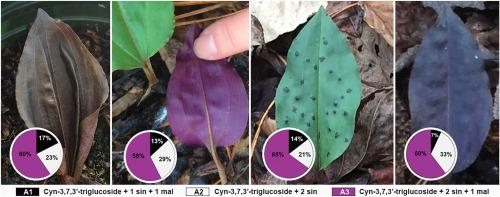当前位置:
X-MOL 学术
›
Plant Sci.
›
论文详情
Our official English website, www.x-mol.net, welcomes your
feedback! (Note: you will need to create a separate account there.)
The same anthocyanins served four different ways: insights into anthocyanin structure-function relationships from the wintergreen orchid, Tipularia discolor
Plant Science ( IF 4.2 ) Pub Date : 2021-02-01 , DOI: 10.1016/j.plantsci.2020.110793 Nicole M. Hughes , Michaela K. Connors , Mary H. Grace , Mary Ann Lila , Brooke N. Willans , Andrew J. Wommack
Plant Science ( IF 4.2 ) Pub Date : 2021-02-01 , DOI: 10.1016/j.plantsci.2020.110793 Nicole M. Hughes , Michaela K. Connors , Mary H. Grace , Mary Ann Lila , Brooke N. Willans , Andrew J. Wommack

|
Over 500 unique anthocyanins have been described to date, which vary in color, antioxidant, light-attenuating, and antimicrobial properties. Identification of anthocyanin chemical structure may therefore serve as an important clue to their in situ function in plants. We characterized the histological and chemical structures of anthocyanins associated with diverse leaf color patterns in the terrestrial orchid, Tipularia discolor, as a step towards understanding their ultimate function. Tipularia discolor produces a single wintergreen leaf in autumn, which is drab brown in color during expansion. Upper (adaxial) surfaces of fully-expanded leaves may be green, purple-spotted, or solid purple, while lower (abaxial) surfaces are bright magenta. Our results showed that the same three cyanidin 3,7,3'-triglucosides, in similar concentrations and proportions, accounted for coloration in each of these cases, and that different colors result from differences in histological location of anthocyanins (i.e. abaxial/adaxial epidermis, mesophyll). Anthocyanins with 3,7,3' linkage positions are rare in plants, occurring only within the orchid subfamily Epidendroideae, to which Tipularia belongs. These results are important to the discussion of anthocyanin structure-function because they serve as a reminder that 1) plants may employ the same anthocyanins in different anatomical locations to achieve a broad range of colors (and potentially adaptive functions), and 2) anthocyanin chemical structure and anatomical location are influenced by phylogenetic inertia, as well as natural selection.
中文翻译:

相同的花青素有四种不同的作用:洞察冬青兰花的花青素结构 - 功能关系,Tipularia discolor
迄今为止,已经描述了 500 多种独特的花青素,它们在颜色、抗氧化、光衰减和抗菌特性方面各不相同。因此,花青素化学结构的鉴定可以作为其在植物中原位功能的重要线索。我们表征了与陆生兰花(Tipularia discolor)中不同叶色图案相关的花青素的组织学和化学结构,作为了解其最终功能的一步。Tipularia discolor 在秋季产生单片冬青叶,在扩张过程中呈棕褐色。完全展开的叶子的上(近轴)表面可能是绿色、紫色斑点或纯紫色,而下(背面)表面是明亮的洋红色。我们的结果表明,相同的三种花青素 3,7,3'-三糖苷,以相似的浓度和比例,解释了每种情况下的着色,并且不同的颜色是由花青素的组织学位置(即背面/正面表皮、叶肉)的差异引起的。具有 3,7,3' 连接位置的花青素在植物中很少见,仅存在于 Tipularia 所属的兰花亚科 Epidendroideae 中。这些结果对于花青素结构功能的讨论很重要,因为它们提醒我们 1) 植物可以在不同的解剖位置使用相同的花青素来实现广泛的颜色(和潜在的适应性功能),以及 2) 花青素化学结构和解剖位置受系统发育惰性以及自然选择的影响。并且不同的颜色是由花青素的组织学位置(即背面/正面表皮、叶肉)的差异引起的。具有 3,7,3' 连接位置的花青素在植物中很少见,仅存在于 Tipularia 所属的兰花亚科 Epidendroideae 中。这些结果对于花青素结构功能的讨论很重要,因为它们提醒我们 1) 植物可以在不同的解剖位置使用相同的花青素来实现广泛的颜色(和潜在的适应性功能),以及 2) 花青素化学结构和解剖位置受系统发育惰性以及自然选择的影响。并且不同的颜色是由花青素的组织学位置(即背面/正面表皮、叶肉)的差异引起的。具有 3,7,3' 连接位置的花青素在植物中很少见,仅存在于 Tipularia 所属的兰花亚科 Epidendroideae 中。这些结果对于花青素结构功能的讨论很重要,因为它们提醒我们 1) 植物可以在不同的解剖位置使用相同的花青素来实现广泛的颜色(和潜在的适应性功能),以及 2) 花青素化学结构和解剖位置受系统发育惰性以及自然选择的影响。连接位置在植物中很少见,仅出现在兰花亚科 Epidendroideae 中,Tipularia 属于。这些结果对于花青素结构功能的讨论很重要,因为它们提醒我们 1) 植物可以在不同的解剖位置使用相同的花青素来实现广泛的颜色(和潜在的适应性功能),以及 2) 花青素化学结构和解剖位置受系统发育惰性以及自然选择的影响。连接位置在植物中很少见,仅出现在兰花亚科 Epidendroideae 中,Tipularia 属于。这些结果对于花青素结构功能的讨论很重要,因为它们提醒我们 1) 植物可以在不同的解剖位置使用相同的花青素来实现广泛的颜色(和潜在的适应性功能),以及 2) 花青素化学结构和解剖位置受系统发育惰性以及自然选择的影响。
更新日期:2021-02-01
中文翻译:

相同的花青素有四种不同的作用:洞察冬青兰花的花青素结构 - 功能关系,Tipularia discolor
迄今为止,已经描述了 500 多种独特的花青素,它们在颜色、抗氧化、光衰减和抗菌特性方面各不相同。因此,花青素化学结构的鉴定可以作为其在植物中原位功能的重要线索。我们表征了与陆生兰花(Tipularia discolor)中不同叶色图案相关的花青素的组织学和化学结构,作为了解其最终功能的一步。Tipularia discolor 在秋季产生单片冬青叶,在扩张过程中呈棕褐色。完全展开的叶子的上(近轴)表面可能是绿色、紫色斑点或纯紫色,而下(背面)表面是明亮的洋红色。我们的结果表明,相同的三种花青素 3,7,3'-三糖苷,以相似的浓度和比例,解释了每种情况下的着色,并且不同的颜色是由花青素的组织学位置(即背面/正面表皮、叶肉)的差异引起的。具有 3,7,3' 连接位置的花青素在植物中很少见,仅存在于 Tipularia 所属的兰花亚科 Epidendroideae 中。这些结果对于花青素结构功能的讨论很重要,因为它们提醒我们 1) 植物可以在不同的解剖位置使用相同的花青素来实现广泛的颜色(和潜在的适应性功能),以及 2) 花青素化学结构和解剖位置受系统发育惰性以及自然选择的影响。并且不同的颜色是由花青素的组织学位置(即背面/正面表皮、叶肉)的差异引起的。具有 3,7,3' 连接位置的花青素在植物中很少见,仅存在于 Tipularia 所属的兰花亚科 Epidendroideae 中。这些结果对于花青素结构功能的讨论很重要,因为它们提醒我们 1) 植物可以在不同的解剖位置使用相同的花青素来实现广泛的颜色(和潜在的适应性功能),以及 2) 花青素化学结构和解剖位置受系统发育惰性以及自然选择的影响。并且不同的颜色是由花青素的组织学位置(即背面/正面表皮、叶肉)的差异引起的。具有 3,7,3' 连接位置的花青素在植物中很少见,仅存在于 Tipularia 所属的兰花亚科 Epidendroideae 中。这些结果对于花青素结构功能的讨论很重要,因为它们提醒我们 1) 植物可以在不同的解剖位置使用相同的花青素来实现广泛的颜色(和潜在的适应性功能),以及 2) 花青素化学结构和解剖位置受系统发育惰性以及自然选择的影响。连接位置在植物中很少见,仅出现在兰花亚科 Epidendroideae 中,Tipularia 属于。这些结果对于花青素结构功能的讨论很重要,因为它们提醒我们 1) 植物可以在不同的解剖位置使用相同的花青素来实现广泛的颜色(和潜在的适应性功能),以及 2) 花青素化学结构和解剖位置受系统发育惰性以及自然选择的影响。连接位置在植物中很少见,仅出现在兰花亚科 Epidendroideae 中,Tipularia 属于。这些结果对于花青素结构功能的讨论很重要,因为它们提醒我们 1) 植物可以在不同的解剖位置使用相同的花青素来实现广泛的颜色(和潜在的适应性功能),以及 2) 花青素化学结构和解剖位置受系统发育惰性以及自然选择的影响。









































 京公网安备 11010802027423号
京公网安备 11010802027423号